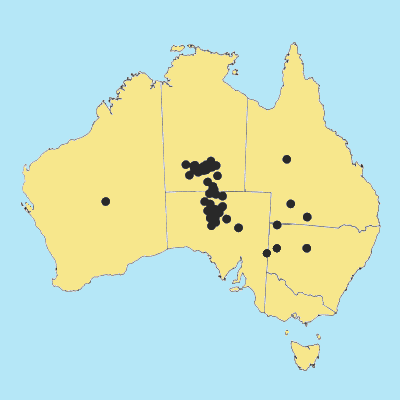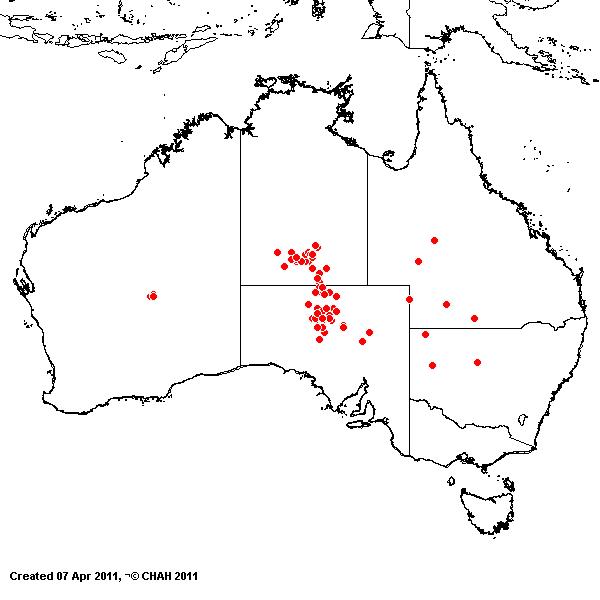Aristida strigosa (Henrard)S.T.Blake
ex J.M.Black. Fl. South Australia Ed.2, 1: 83 (1943).
Classification. (GPWG 2001) : Subfamily Aristidoideae. Aristideae.
Basionym and/or
Replacement Name: Aristida
calycina var. strigosa Henrard, Meded. Rijks-Herb. 58(A): 297
(1932).
Type of Basionym or
Protologue Information: LT: R. Helms 23, 15 May 1891, Australia:
South Australia: Arkaringa Creek, Elder Exploring Expedition (K (photo, BRI);
IT: AD, BRI, BRI (fragm. ex K), MEL). LT designated by Henrard, Meded.
Rijks-Herb. 54(C): 708 (1933).
Key references
(books and floras): [1952] C.A.Gardner, Flora of Western Australia 1
Gramineae (166), [1981] M.Lazarides in J.Jessop (ed)., Flora of
Central Australia (450), [2002] D.Sharp & B.K.Simon, AusGrass,
Grasses of Australia, [2006] J.Jessop, G.R.M.Dashorst, F.M.James, Grasses
of South Australia (329), [2008] S.W.L.Jacobs, R.D.B.Walley &
D.J.B.Wheeler, Grasses of New South Wales (132).
Illustrations:
[1983] J.C.Tothill & J.B.Hacker, Grasses of Southern Queensland
(106(32)), [2005] K.Mallet (ed.), Flora of Australia 44B: Poaceae 3
(Fig. 19C-D), [2006] J.Jessop, G.R.M.Dashorst, F.M.James, Grasses of South
Australia (329, Fig. 262), [2008]
S.W.L.Jacobs, R.D.B.Whalley & D.J.B.Wheeler, Grasses of New South Wales,
4th edn (132).
Derivation: L.
covered with short, bristle-like hairs. One or more organs covered with
bristle-like hairs.
Habit.
Perennial. Culms 50–120 cm tall, 3–6 -noded. Mid-culm internodes glabrous.
Lateral branches sparsely branched or branched. Leaf-sheaths scaberulous or
antrorsely scabrous. Ligule a fringe of hairs, 0.5–1 mm long. Leaf-blades
straight, flat or conduplicate or involute or convolute, 9–18 cm long, 2–3 mm
wide. Leaf-blade surface scabrous.
Inflorescence.
Inflorescence compound, a panicle. Panicle linear, 16–36 cm long, 1.5–3 cm
wide.
Spikelets.
Spikelets pedicelled. Fertile spikelets 1-flowered, comprising 1 fertile
floret(s), without rachilla extension, lanceolate, terete, 8.5–12 mm long.
Glumes. Glumes
similar, thinner than fertile lemma. Lower glume lanceolate, membranous,
keeled, 1-keeled, 1 -nerved. Lower glume apex mucronate. Upper glume
lanceolate, 7–12 mm long, membranous, keeled, 1-keeled, 1 -nerved. Upper glume
apex entire or erose, muticous or mucronate.
Florets. Fertile
lemma 8.5–12 mm long, without keel, 3 -nerved. Lemma apex awned, 3 -awned.
Median (principal) awn without a column. Lateral lemma awns present. Palea
without keels. Anthers 3. Grain 5–8 mm long.
Continental
Distribution: Australasia.
Australian
Distribution: Western Australia, Northern Territory, South Australia,
Queensland, New South Wales.
Western Australia:
Ashburton. Northern Territory: Central Australia North, Central
Australia South. South Australia: North-western, Lake Eyre, Eastern. Queensland:
Gregory North, Gregory South, Warrego. New South Wales: North Far
Western Plains.
Notes.
A. strigosa resembles A. capillifolia in that it has distinctly
scabrous lemmas as opposed to tuberculate spiny lemmas found in A. nitidula,
A. arida and A. platychaeta. It differs from A. capillifolia
by having flat to conduplicate leaf blades and longer lemmas.
Mainly from southern
part of the N.T. to northern South Australia with scattered distribution in all
mainland states except Victoria. Rocky creek beds and associated sandy or loamy
alluvial soils. Flowering and fruiting January to November.



